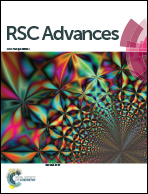Optimization of the combined ultrasonic assisted/adsorption method for the removal of malachite green by zinc sulfide nanoparticles loaded on activated carbon: experimental design
Abstract
The aim of the present study is experimental design optimization applied to the removal of malachite green (MG) from aqueous solution by ultrasound-assisted removal onto zinc sulfide nanoparticles loaded on activated carbon (ZnS-NP-AC). The nanomaterial was characterized using different techniques such as FESEM, BET, XRD and UV-Vis measurements. The effects of variables such as pH, initial dye concentration, adsorbent dosage (g) and sonication time on MG removal were studied using central composite design (CCD) and the optimum experimental conditions were found with a desirability function (DF) combined with response surface methodology (RSM). Fitting the experimental equilibrium data to various isotherm models showed the suitability and applicability of the Langmuir model and the second-order equation model controls the kinetics of the adsorption process. A small amount of proposed adsorbent (0.025 g) is applicable for successful removal of 22 mg L−1 MG (>99%) in a short time (5.0 min).


 Please wait while we load your content...
Please wait while we load your content...